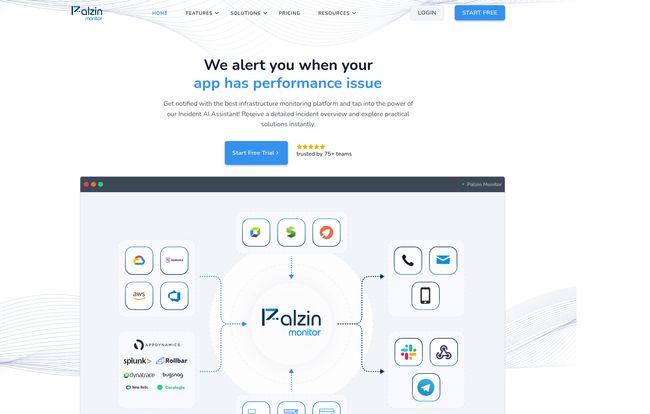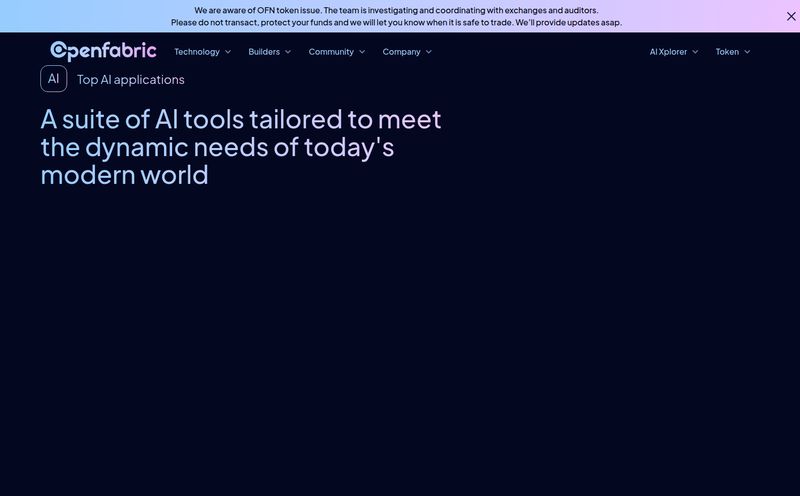Ever had that cold sweat moment? It’s 3 AM. Your phone buzzes, not with a late-night meme, but with a notification from a payment gateway. Transaction failed. You check your email. A handful of angry customer support tickets have trickled in. The dreadful realization hits you: your website is down. And you have no idea for how long.
I’ve been in the SEO and traffic game for years, and I can tell you, nothing tanks your rankings and burns your ad spend faster than downtime. It’s the silent killer of conversions. For years, the solution was a patchwork of different tools—one for pings, one for SSL, another for… well, you get the picture. It was a clunky, expensive mess.
Then I stumbled upon Palzin Monitor. It promised to be a simple, all-in-one platform. A single dashboard to rule them all. But we’ve heard that promise before, haven’t we? So, I decided to take a proper look, peel back the marketing layers, and see if it’s genuinely the watchdog your website needs or just another tool gathering digital dust. Let’s get into it.
So, What Exactly is Palzin Monitor?
At its heart, Palzin Monitor is an uptime monitoring platform. But that's a bit like saying a smartphone is just a device for making calls. It’s technically true, but misses the whole point. Palzin is designed to be your eyes and ears on the internet, constantly checking to make sure your digital properties—websites, servers, APIs—are alive and well.
But it goes further. It’s not just a smoke alarm that shrieks when there’s a fire. It tries to be the firefighter, too. With built-in incident management and even an AI assistant, it aims to move beyond simple alerts to help you actually diagnose and fix the problem. It’s a tool built for the modern DevOps culture, where everyone from the lead engineer to the marketing manager has a stake in performance. It feels less like a piece of software and more like a new, incredibly diligent member of your team.
The Features That Actually Matter
A feature list can be a mile long, but what really counts? I've managed dozens of websites, and I know which alerts keep me up at night. Here’s how Palzin stacks up on the things that make a difference.

Visit Palzin Monitor
#
Uptime Monitoring is Just the Start
Of course, it does the basics. Website Monitoring is the bread and butter. You give it a URL, and it checks it at regular intervals (down to 1 minute) from multiple locations to make sure it’s not just a local network hiccup. This is table stakes, but Palzin does it well. Then you’ve got Ping Monitoring to check server responsiveness and SSL Monitoring, which is an absolute godsend. There's nothing more embarrassing than having a giant “NOT SECURE” warning greet your visitors because you forgot to renew a certificate. Palzin watches that for you and gives you a heads-up before it expires.
Going Deeper than a Simple Ping
This is where things get interesting. Palzin isn’t content with just knowing if your site is 'up'. It wants to know if it’s working correctly. Keyword Monitoring is a clever feature; it checks if a specific word or phrase is present (or absent) on a page. Think “Out of Stock” on a product page or “Error 500” on your homepage. It’s a simple, but powerful, way to catch application-level failures that a simple ping would miss. It also offers Port Monitoring (is your database port open?), DNS Monitoring (to prevent hijacking), and Heartbeat Monitoring for your cron jobs. This is the difference between a simple checkup and a full diagnostic scan.
#
The Incident Management and AI Assistant
Here’s the part that really caught my eye. Getting an alert that your site is down is one thing. Figuring out why and coordinating a fix is another. Palzin has built-in Incident Management. When a monitor fails, it doesn’t just send a one-off alert; it creates an 'incident.' This incident can have its own alerts, assignees, and updates. It’s a mini-control center for your outage.
And then there’s the Incident AI Assistant. This is a very 2024 feature, and I'm here for it. The idea is that the AI can analyze the incident data and provide insights or potential root causes. While I haven't seen it solve a complex outage on its own, having an AI point you in the right direction—'It looks like this outage started right after a new code deployment'—could shave precious minutes, or even hours, off your resolution time. It's an ambitious feature that shows the platform's forward-thinking direction.
Application Performance Monitoring (APM)
For the developers in the room, this is huge. Palzin is dipping its toes into the world of APM. This isn't just about whether your site is up; it's about how fast it is. APM tools help you spot bottlenecks in your code, slow database queries, and other performance drags that frustrate users and hurt your bottom line. Integrating this with uptime monitoring is a smart move, putting infrastructure health and application health under one roof.
Keeping Your Users in the Loop with Status Pages
Remember that 3 AM outage? Imagine if, instead of angry emails, your users found a beautiful status page explaining the issue and when you expect to be back online. That’s what Status Pages do. Palzin lets you create customizable, public or private status pages. It’s a massive trust-builder. Being transparent about downtime can turn a frustrating experience into a moment of confidence in your brand. I once worked for a SaaS company where a well-managed status page during a major AWS outage probably saved us from dozens of cancellations. It's that important.
#
How Much Does Palzin Monitor Cost?
Alright, let's talk money. A great tool is only great if you can afford it. Palzin uses a tiered pricing model that seems aimed at scaling with your business. Here’s a quick breakdown I pulled from their pricing page.
| Plan | Price | Details |
|---|---|---|
| Starter | $8 / month | 10-50 Monitors, includes 10-20 alert credits. |
| Growth | $34 / month | 100 Monitors, includes 30 alert credits. |
| Business | $90 / month | 200 Monitors, includes 50 alert credits. |
| Enterprise | $300+ / month | 300-1000+ Monitors, includes 50-200 alert credits. |
The pricing feels competitive, especially at the lower end. The Starter plan is a great entry point for small businesses or freelancers. The thing to watch is the credit system for SMS and voice call alerts. You get a certain number included, but if you need more, you have to buy them. This is pretty standard practice, but it's something to budget for if your team relies heavily on phone alerts.
What I Like and What Gives Me Pause
No tool is perfect. After spending time with Palzin Monitor, here's my honest take on the good and the... not-so-good.
The Good Stuff
The sheer breadth of monitoring types is fantastic. It's not just uptime; it's a comprehensive health check. The combination of monitoring with incident management is the platform's superpower. It closes the loop between knowing there's a problem and organizing the response. And I'm genuinely excited about the direction of the AI Assistant and APM features. It shows they're not just building for today, they’re building for tomorrow.
A Few Things to Consider
While the feature list is impressive, some are still marked as 'Coming Soon'. This isn’t a deal-breaker, but it’s something to be awere of if you're buying in for a specific feature that isn't fully live yet. Also, the pricing can climb as you add more monitors and team members. For large enterprises, the cost will be a factor, though the value might justify it. And as mentioned, the pay-for-credits system for SMS/calls needs to be factored into your operational costs.
Who is Palzin Monitor Really For?
So, who should sign up for the free trial? In my opinion, Palzin hits a sweet spot for a few groups:
- Agile Startups and Scale-ups: Teams that need a powerful, all-in-one tool without the enterprise-level complexity or price tag of something like Datadog.
- DevOps and SRE Teams: The incident management and APM features are clearly built with engineers in mind.
- Digital Agencies: Managing a portfolio of client websites? A tool like this is a must-have for offering proactive support and SLAs.
- Small Businesses with Critical Websites: If your e-commerce store or booking site going down means you're losing money every minute, the $8/mo Starter plan is a no-brainer investment.
If you just need a simple, free ping test for a personal blog, this might be overkill. But for any serious business operating online, the feature set is compelling.
#
My Final Thoughts on Palzin Monitor
Look, I'm a cynic when it comes to new tools. I've seen too many promise to revolutionize my workflow only to become another forgotten browser tab. But I'm genuinely impressed with Palzin Monitor. It's a thoughtful, well-designed platform that understands the real-world problems of running a website.
It’s not just about alerts. It’s about context, management, and resolution. Is it the perfect, end-all-be-all solution for every company on earth? Of course not. But it is a powerful, smart, and surprisingly accessible platform that can prevent that 3 AM panic. And for me, a good night’s sleep is worth a lot more than $8 a month.
Frequently Asked Questions
- What is Palzin Monitor in a nutshell?
- It's an all-in-one monitoring platform that checks your website's uptime, performance, and health. It also includes tools for managing outages (incident management) and an AI assistant to help diagnose problems.
- Does Palzin Monitor offer a free trial?
- Yes, according to their website and the information available, they offer a free trial so you can test out the features before committing to a paid plan.
- What kind of alerts can I receive?
- Palzin Monitor supports a wide range of alert channels, including email, SMS (text messages), voice calls, and integrations with popular team communication tools like Slack and PagerDuty.
- Is Palzin Monitor only for websites?
- No. While website uptime is a core feature, it can also monitor servers (via ping), specific network ports, DNS records, cron jobs (via heartbeats), and even application performance (APM).
- How does the pricing for SMS/Voice call alerts work?
- Each pricing plan comes with a set number of included 'credits' per month. SMS messages and voice calls consume these credits. If you need more than your plan provides, you can purchase additional credits.
- Is the AI assistant actually useful?
- The goal of the AI assistant is to analyze outage data and suggest potential root causes, which can speed up troubleshooting. Its effectiveness will likely vary depending on the complexity of the issue, but it represents a modern approach to incident response that could be very valuable.



